.
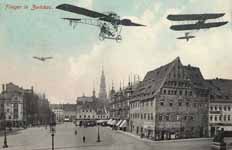
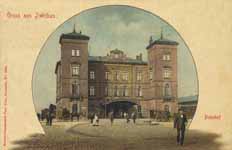

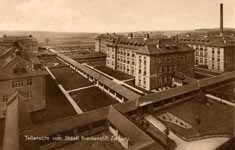
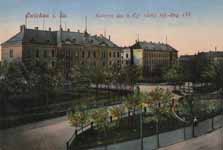
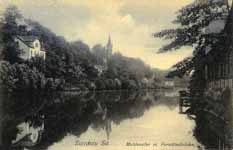
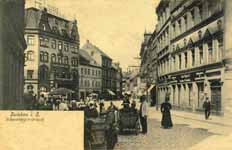
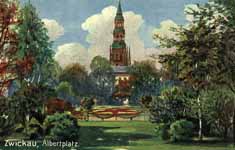
10, 11, 12,
Zwickau
Zwickau (German pronunciation: [ˈtsvɪkaʊ]) in Germany, former seat of the government of the south-western region of the Free State of Saxony, belongs to an industrial and economical core region. Nowadays it is the capital city of the district of Zwickau. The city is situated in a valley at the foot of the Erzgebirge mountains and is also part of the so-called Saxon triangle metropolitan area, an economic network which includes Leipzig-Halle, Dresden. The city has slightly fewer than 100,000 inhabitants but has a regional catchment area of over 480,000 people.
The city can be easily reached by car via the nearby Autobahns A4 and A72. The city has a main railway station (Zwickau-Hbf) and is also reachable via a public airfield which takes light aircraft.
Zwickau, known as the city of Automobiles and Robert Schumann, is the cradle of the Saxon automotive industry with an over one hundred year old tradition. The city has a long history of automotive development and automobile industry along with Auto Union. Well known beyond Germany's borders are trademarks such as Horch, Audi, Trabant and Volkswagen. The "Westsächsische Hochschule Zwickau" - University of Applied Sciences - has therefore always been an important centre for automotive development.
The valley of the 166 km long Zwickauer Mulde river stretches from the Vogtland to the famous Colditz Castle at the other extreme. The Silver Road, Saxony's longest scenic road, connects Dresden with Zwickau.
The German ADAC City Guide recently wrote, "The town of Zwickau has transformed itself over the years from a traditional mining town into an elegant Art-Nouveau town, which is well worth discovering.“
History at a Glance
The main market of Zwickau
Town hall, main facade from 1866-67 and earlier.
The river Zwickauer Mulde in Zwickau
The city of Zwickau has an almost 900-year-old history. As early as the 14th century there was domestic hard-coal processing. Because of the silver ore deposits in the Erzgebirge, Zwickau developed in the 15th and 16th centuries and grew to be an important economic and cultural centre of Saxony.
After Wittenberg, it became the first city in Europe to join the Lutheran Reformation. In the 19th century the city's economy was driven by industrial hard-coal mining. The old city of Zwickau, perched on a hill, is surrounded by gentle heights with extensive forests and a scenic municipal park. Its surroundings offer many opportunities for excursions - to the Hartenstein area, for example, with its castle "Stein", and the "Prinzenhöhle", with its castle "Wolfsbrunn" (nowadays a luxury 5-star Hotel), as well as the Auersberg (1019 meters) with the popular winter sport region of Johanngeorgenstadt and the Vogtland.
In the Old Town the Cathedral and the Gewandhaus (historic cloth merchants' hall) recall the flourishing ecclesiastical, trade and artistic life of the 16th century, which was based on Schneeberg silver. Zwickau was the main site of the Saxon coal miners, and at the same time one of the most important industrial towns of the country. It is also the cradle of the Saxon automobile industry.
When the noise of the shops subsides, one can hear the music of Robert Schumann (1810–1856), which is a special cultural event of art and history for all visitors to the city.
The German actor Gert Fröbe, well known as the bad guy Auric Goldfinger in the James Bond film Goldfinger, was born in Zwickau.
On April 17, 1945 the Second World War ended for Zwickau when the city was occupied by the US Army. After the withdrawal of the US Army on June 30, 1945 Zwickau was occupied by the Soviet Red Army. Between 1944 and 2003, the city had a population of more than 100,000 inhabitants.
Today, the most important employer in the region is Volkswagen-Saxony Ltd. which assembles its models Golf, Passat and Phaeton in the Zwickau-Mosel vehicle plant.
Audi-AG together with the city of Zwickau operates the August Horch Museum in the former Audi works. It is known far beyond Germany's borders and is very much worth seeing
Boundaries
Zwickau is bounded by Mülsen, Reinsdorf, Wilkau-Haßlau, Hirschfeld (Verwaltungsgemeinschaft Kirchberg), Lichtentanne, Werdau, Neukirchen, Crimmitschau, Dennheritz (Verwaltungsgemeinschaft Crimmitschau) and the city of Glauchau.
Incorporations
1895: Pölbitz
1902: Marienthal
1905: Eckersbach
1922: Weißenborn
January 1, 1923: Schedewitz
1939: Brand and Bockwa
January 1, 1944: Oberhohndorf and Planitz (with Oberplanitz, Neuplanitz und Niederplanitz)
February 1, 1953: Auerbach, Pöhlau and Niederhohndorf
July 1, 1993: Hartmannsdorf
April 1, 1996: Rottmannsdorf
October 1, 1996: Crossen (with 4 municipalities on Janutary 1, 1994 Schneppendorf)
January 1, 1999: Cainsdorf, Mosel, Oberrothenbach and Schlunzig along with Hüttelsgrün (Lichtentanne) and Freiheitssiedlung
Districts
City centre (11–15):
Inner city (11), Centre-North (12), Centre-West (13), Centre-South (14), Suburb North (15)
Urban district East (21–28):
Region Äußere Dresdner Straße/Pöhlauer Straße (21), Eckersbach Housing estate (22), Pöhlau (23), Auerbach (24), Eckersbacher Höhe (E 5/1) (25), Eckersbacher Höhe (E 5/2 und E 5/3) (26), Eckersbacher Höhe (E 1 bis E 4) (27), Region Talstraße/Trillerberg (28)
Urban district Nord (31–39):
Pölbitz (31),Weissenborn (32), Niederhohndorf (33), Hartmannsdorf (34), Oberrothenbach¹ (35), Mosel¹ (36), Crossen¹ (37), Schneppendorf (38), Schlunzig¹ (39)
Urban district West (41–44):
Region Reichenbacher Straße und Freiheitssiedlung (41), Marienthal East (42), Marienthal West (43), Brand (44)
Urban district South (51–59):
Bockwa (51), Oberhohndorf (52), Schedewitz (53), Niederplanitz (54), Neuplanitz (55), Hüttelsgrün (56), Oberplanitz (57), Rottmannsdorf¹ (58), Cainsdorf¹ (59)
Population
Year Population
1462 ca. 3,900
1530 ca. 7,677
1640 2,693
1723 3,753
1800 4,189
1840 9,740
1861 20,492
1871 27,322
December 1, 1875 ¹ 31,491
December 1, 1890 ¹ 44,198
December 1, 1900 ¹ 55,825
December 1, 1905 ¹ 68,502
December 1, 1910 ¹ 73,542
June 16, 1925 ¹ 80,358
June 16, 1933 ¹ 84,701
May 17, 1939 ¹ 85,198
October 29, 1946 122,862
August 31, 1950 138,844
December 1, 1960 129,138
December 31, 1972 124,796
June 30, 1981 121,800
1986 120,900
June 30, 1997 102,100
December 31, 2002 100,892
June 30, 2006 97,232
¹ Census data
History
St. Marys church, at dusk.
St. Catharine's church
The region around Zwickau was settled by Slavs as early as the 7th century. In the 10th century, German settlers began arriving and the native Slavs were Christianized. A trading place known as terretorio Zcwickaw was mentioned in 1118. The settlement received a town charter in 1212 and hosted Franciscans and Cistercians during the 13th century. Zwickau was a free imperial city from 1290–1323, but was subsequently granted to the margraves of Meissen. Although regional mining began in 1316, extensive mining increased with the discovery of silver in the Schneeberg in 1470.
Among the nine churches, the fine Gothic church of St. Mary (1451–1536), with a spire 285 ft. high and a bell weighing 51 tons, stands out. The church contains an altar with wood-carving, eight paintings by Michael Wohlgemuth and a remarkable pietà in carved and painted wood by Peter Breuer.
The late Gothic church of St. Catharine[disambiguation needed ] has an altar piece ascribed to Lucas Cranach the elder, and is remembered because Thomas Müntzer was once pastor there (1520–22). Of the secular buildings the most noteworthy are the town hall, begun in 1404 and rebuilt many times since then. The municipal archives include documents dating back to the 13th century.
The carefully preserved treasures of art and literature (early printed books from the Middle Ages), documents, letters and books are kept in the Town Archives (e.g. Hans Sachs (*1494 - 1576): Meister Singer volumes), and in the School Library founded by scholars and by the town clerk Stephan Roth during the Reformation.
In 1520 Martin Luther dedicated his treatise "On the Freedom of the Christian Man" to his friend Hermann Muehlpfort, the Lord Mayor of Zwickau. The Anabaptist movement of 1525 began at Zwickau under the inspiration of the "Zwickau prophets". The late Gothic Gewandhaus (cloth merchants' hall), was built in 1522-24 and is now converted into a theatre. Confessional warfare devastated the city during the Thirty Years' War.
In 1810, on June 8, the pianist and composer Robert Schumann was born in Zwickau.
Economic history
Hard coal mine Brückenberg I (later Karl-Marx) in 1948
Production of the last Trabants in 1990
Hard-coal mining is mentioned as early as 1348. However, mining on an industrial scale first started in the early 19th century. The hard-coal mines of Zwickau, and the neighbouring Oelsnitz-Lugau coalfield contributed significantly to the industrialisation of the region and the town.
Many industrial branches developed in the town in the wake of the hard-coal mining industry: mining equipment, iron and steel works, textile, machinery in addition to chemical, porcelain, paper, glass, dyestuffs, wire goods, tinware, stockings, and curtains. There were also steam saw-mills, diamond and glass polishing works, iron-foundries, and breweries.
In 1904 the Horch automobile plant was founded, followed by Audi factory in 1909. In 1932 both brands were incorporated into the Auto Union but retained their independent trademarks. The racing cars of the Auto Union, developed by Ferdinand Porsche and Robert Eberan von Eberhorst, driven by Bernd Rosemeyer, Hans Stuck, Tazio Nuvolari, Ernst von Delius, became well known all over the world. During WWII, the NAZI government operated a satellite camp of the Flossenbürg-Nazi concentration camp in Zwickau, which was sited near the Auto Union plant HORCH. The NAZI administration installed at the Osterstein Castle a hard labour punishment camp. Both camps were liberated by US Army in 1945. After WWII, from 1945, August 1, the military administration was taken over from the US by the Soviet Army. The Auto Union factories of HORCH and AUDI were disassembled by the Russians. In 1948 all large companies were expropriated by the East German administration.
With the founding of the German Democratic Republic in 1949 in East Germany, the difficult post-war reconstruction began. In 1958 the Horch and Audi factories were merged into the Sachsenring plant. At the "Sachsenring" automotive plant the compact "Trabant" cars were manufactured. These small cars had a two-cylinder, two-stroke engine. The car was the first vehicle in the world to be industrially manufactured with a plastic car body.
For a long period of its history, the Zwickau was the centre of hard-coal mining. In 1885 Carl Wolf invented an improved gas-detecting safety mining-lamp. He held the first world patent for it. Together with his business partner Friemann he founded the "Friemann & Wolf" factory. The plant was one of the first Germany global players in the 19th century. Coal mining was abandoned for economical reasons in 1978 after about 230 millions tonnes had been mined from the Carboniferous deposit to depths of over 1,000 metres. However, Zwickau remained a mining-related town until 1992 when the last coke oven plant operated in the town was closed. The closure of the plant marked the historical end of 700 years of hard-coal industry in Saxony.
Two major industrial facilities of the Soviet SDAG Wismut were situated in the city: the uranium mill in Zwickau-Crossen, producing uranium concentrate (so called "yellow cake") from ores of mines in the Erzgebirge and Thuringia, and the machine building plant in Zwickau-Cainsdorf producing various equipment for the uranium mines and mills of East Germany. Uranium milling ended in 1989, and after the reunification the Wismut machine building plant was sold to a private investor.
Economy
The production of the Trabant was discontinued after German reunification, but Volkswagen built a new factory, and Sachsenring is now a supplier for the automobile industry. Nowadays the headquarter of the Volkswagen-Saxony Ltd. (a VW subsidiary) is situated in the northern part of Zwickau.
Education
Zwickau is home to the West Saxon University of Applied Sciences with about 5200 students and two campuses in the area of Zwickau.
Transport
Zwickau is connected to the Autobahn A72 (Chemnitz-Hof) south of the town and to the A4 (Dresden-Erfurt) 15 km north of the town.
Zwickau Hauptbahnhof is on the Dresden–Werdau line, part of the Saxon-Franconian trunk line, connecting Nuremberg and Dresden. There are further railway connections to Leipzig as well as Karlovy Vary and Cheb in the Czech Republic.
The closest airport is *Leipzig-Altenburg with a very limited number of flights by the low cost carrier Ryan Air. The next major airports are Leipzig-Halle and Dresden offering a large number of national and international flights.
Museums
House where Robert Schumann was born 1810, museum at Hauptmarkt 5
In the town centre there are three museums: an art museum from the 19th century and the houses of priests from 13th century, both located next to St. Mary's church. Just around the corner there is the Robert-Schumann museum. The museums offer different collections dedicated to the history of the town, as well as art and a mineralogical, palaeontological and geological collection with many specimens from the town and the nearby Erzgebirge Mts. and the music of the romantic school.
Zwickau is also the birthplace of Robert Schumann. The house where he was born in 1810 still stands in the marketplace. There is a museum dedicated to him.
The history of the Horch automobile factory is presented at the August Horch Museum, an Anchor Point of ERIH, The European Route of Industrial Heritage.
Historical mayors of Zwickau
1501 - 1518: Erasmus Stella
1518 - 1530: Hermann Mühlpfort
Carl Wilhelm Ferber: 1800, 1802, 1804, 1806, 1808, 1810, 1812, 1814
Tobias Hempel: 1801, 1803, 1805, 1807, 1809, 1811, 1813, 1815, 1817, 1819
Christian Gottlieb Haugk: 1816, 1818, 1820, 1822
Carl Heinrich Rappius: 1821, 1823, 1825, 1826
1824: Christian Heinrich Pinther
1827 - 1830: Christian Heinrich Mühlmann, Stadtvogt
1830 - 1832: Franz Adolf Marbach
1832 - 1860: Friedrich Wilhelm Meyer
1860 - 1898: Lothar Streit, from 1874 Lord Mayor
1898 - 1919: Karl Keil
1919 - 1934: Richard Holz
1934–1945: Ewald Dost
1945: Fritz Weber, (acting Lord Mayor)
1945: Georg Ulrich Handke, (acting Lord Mayor)
1945 - 1949: Paul Müller
1949 - 1954: Otto Aßmann
1954 - 1958: Otto Schneider
1958 - 1969: Gustav Seifried
1969 - 1973: Liesbeth Windisch
1973 - 1977: Helmut Repmann
1977 - 1990: Heiner Fischer
1990 - 2001: Rainer Eichhorn
2001 - 2008: Dietmar Vettermann
2008 : Dr. Pia Findeiß
Twinnings
Czech Republic Jablonec nad Nisou, Czech Republic, since 1971
Netherlands Zaanstad, Netherlands, since 1987
Germany Dortmund, North Rhine-Westphalia, Germany, since 1988
References
^ "Bevölkerung des Freistaates Sachsen jeweils am Monatsende ausgewählter Berichtsmonate nach Gemeinden" (in German). Statistisches Landesamt des Freistaates Sachsen. 31 July 2011.
This article incorporates text from a publication now in the public domain: Chisholm, Hugh, ed. (1911). Encyclopædia Britannica (11th ed.). Cambridge University Press.
From Wikipedia, All text is available under the terms of the GNU Free Documentation License

